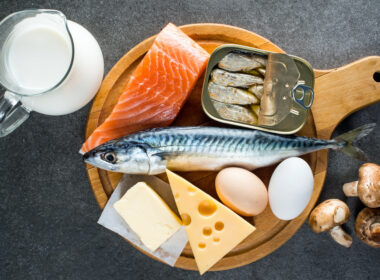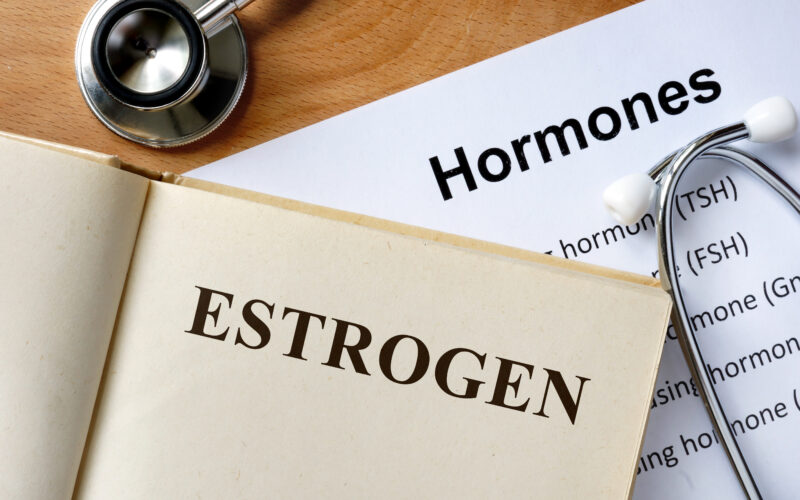What do you know about estrogen? Maybe you’ve heard that it’s part of hormone replacement therapy, or maybe you’ve been diagnosed with polycystic ovary syndrome (PCOS) and have been told that you have “estrogen dominance.” In this article, we’ll explore what estrogen is, where it’s made, what it does, and its specific connections to: pregnancy (and infertility), polycystic ovary syndrome, hormonal birth control, and breast cancer.
What is Estrogen?
Estrogen is a naturally occurring hormone produced in both men and women, though women produce much more estrogen throughout their lifetime than men do. In women, estrogen is produced primarily by the ovaries until menopause (see more on this below). Much smaller amounts of estrogen are produced by the breasts, the liver, the adrenal glands, and fat cells.
The female body makes several types of estrogen at different stages in life, including estrone (E1), estradiol (E2), and estriol (E3). Estradiol (E2) is the most common type among women of childbearing age. Estriol (E3) is made almost exclusively during pregnancy. Estrone (E1) is the dominant form of estrogen after menopause.
What does Estrogen do throughout the reproductive lifespan?
As young girls approach puberty, increased levels of estrogen trigger the process of sexual maturation. This maturation is evidenced by increased breast size, growth of underarm and pubic hair (predominantly regulated by testosterone), and changes to the young woman’s bone structure (such as widening of the hips). Estrogen is also responsible for growth and maturation of the vagina, uterus, and fallopian tubes.
Throughout a woman’s reproductive lifespan, estrogen also plays a major role in menstrual cycle regulation. In the first half of the cycle leading up to ovulation, estrogen levels are high. Peak levels of estrogen leading up to ovulation stimulate the production of peak-type cervical mucus, or egg white cervical mucus, which is one of three necessary components for conception to occur. Estrogen also causes cyclical regrowth of the uterine lining (the endometrium) after it sheds during menstruation. Estrogen furthermore plays a significant role in pregnancy as well as a not yet well-defined role in female sexual desire [1].
As a woman approaches menopause, telltale signs of decreasing estrogen levels include hot flashes and vaginal dryness, itching, and burning. (Incidentally, many women experience vaginal dryness and tenderness in the immediate postpartum period, when estrogen levels have dropped precipitously following their pre-delivery peak.) And while conventional hormone replacement therapy (HRT) comes with some significant risks, bioidentical hormones prescribed to symptomatic women at safe and effective levels can help relieve some common perimenopausal discomforts (however, it should be noted that even bioidentical estrogen, like synthetic estrogen, can increase the risk of breast cancers) [2].
Estrogen and Pregnancy
Estrogen levels climb to all-time highs over the course of a pregnancy. While the ovaries normally produce estradiol (E2), during pregnancy, the placenta makes estrogen primarily as estriol (E3). Early in the pregnancy, estrogen produced by the ovaries supports growth of the placenta, which is the baby’s nutritional and oxygen pipeline plus his or her waste conduit. Gradually, the placenta itself makes estrogen (E3 kind). As Dr. Jolene Brighten explains in detail here, estrogen tells the mother’s body to significantly increase blood supply to the uterus for the benefit of the growing baby, and it tells the baby’s body organs to develop [3]. Later in the pregnancy, estrogen “tells” the mother’s breast cells to start producing milk.
Wondering what causes that “pregnancy glow” or, conversely, melasma, the “mask of pregnancy?” Estrogen is the answer on both counts!
What else does Estrogen do in the body?
Beyond the reproductive system, estrogen has far-reaching effects throughout the body. According to the Johns Hopkins University School of Medicine, estrogen also impacts “the urinary tract, the heart and blood vessels, bones, breasts, skin, hair, mucous membranes, pelvic muscles, and the brain.” For example, NaProTechnology’s founder Dr. Thomas Hilgers notes in his book, The NaProTechnology Revolution: Unleashing the Power in a Woman’s Cycle, that estrogen impacts the cardiovascular system by raising “good cholesterol” (HDL) levels and decreasing “bad cholesterol” (LDL) levels. Natural Womanhood previously did a deep dive into estrogen’s specific impact on the brain, heart, musculoskeletal, and immune systems in the Reasons Women Need Periods series.
Too Much Estrogen
Too much estrogen in the body, particularly in terms of a deficit of other reproductive hormones like progesterone, is called “estrogen dominance.” Estrogen dominance has real implications for women’s health. Women with polycystic ovary syndrome (PCOS), the most common cause of infertility in women, are more likely to exhibit estrogen dominance. In fact, the ovaries’ overproduction of estrogen is the cause of the many follicular cysts often seen in “polycystic” ovary syndrome.
Whereas low levels of estrogen can cause infertility, too-high levels are also associated with infertility if—as can happen in PCOS—estrogen remains high throughout the cycle because of dysfunctional ovulation or not ovulating altogether. Estrogen dominance in the context of too little progesterone is also associated with infertility. Estrogen dominance is unfortunately also associated with an increased risk for breast and endometrial cancers.
Estrogen dominance is also sometimes seen in endometriosis.
Too Little Estrogen
As Natural Womanhood previously noted, women may have low estrogen levels for one of the following reasons: they may be post-menopausal, suffering from an eating disorder, an athlete with hypothalamic amenorrhea, taking hormonal birth control, or under tremendous stress.
Dr. Jolene Brighten succinctly summarizes the negative results of having low estrogen levels: “Low estrogen levels are linked to lower fertility, increased risk of miscarriage and a woman with below-normal estrogen may have difficulty becoming pregnant.” In particular, infertility related to low estrogen makes sense when we recall that estrogen stimulates production of egg white cervical mucus, or good quality, fertile mucus that helps sperm survive and swim up to the egg for fertilization. Without fertile mucus, the sperm is trapped in the vagina. (More information on increasing the amount and improving the quality of cervical mucus can be found here.)
Synthetic Estrogen in Hormonal Birth Control
Hormonal birth control (HBC), whether administered via pill, patch, or ring primarily works by stopping ovulation—and the heavy lifting of this task is typically done by progestin, a synthetic form of progesterone. Progestin has numerous nasty side effects in the body and none of the many health benefits of natural progesterone. In the ovulation-stopping scenario, synthetic estrogen is primarily along for the ride, added to HBC in an attempt to counteract the many negative impacts of only giving synthetic progestin.
Synthetic estrogen, however, can cause problems of its own. This makes sense given that hormonal birth control is the only medicine intended to create a “doctor-prescribed hormonal imbalance.” Among the risks of taking oral estrogen is an increased risk of breast cancer. Research also suggests that synthetic estrogen may harm gut health [4]. Furthermore, while natural estrogen in the body directly protects bone heath, research suggests that women taking hormonal birth control, even young women, are at increased risk for bone fractures during their early reproductive years and for osteoporosis later in life. This is likely because HBC provides continuous small amounts of synthetic estrogen, so the body isn’t exposed to the higher levels of estrogen that come from ovulating regularly and normally.
The synthetic estrogen in hormonal birth control may be even more problematic for women with PCOS, who are routinely offered HBC as a band-aid solution for their symptoms. To quote a previous Natural Womanhood article: “A mainstream treatment for PCOS is hormonal birth control or other artificial hormones. Unfortunately, if a woman has insulin resistance, hormonal birth control can further increase her cortisol levels, (increasing the risk of heart disease and stroke), exacerbate estrogen dominance (increasing the risk of cancer), and increase her risk of depression.”
Estrogen and Breast Cancer
Excessive levels of estrogen in the body have been shown to increase a woman’s risk of developing breast cancer. Why is this? According to the Maurer Foundation, an organization that provides breast cancer education, “80% of all breast cancers grow according to estrogen supply. These are called hormone-receptor-positive breast cancers (or hormone-sensitive breast cancers). This is a very powerful factor to identify because these cancers can be treated effectively by restricting estrogen production in the body.” Medications for hormone-related breast cancer, typically “either lower estrogen levels or stop estrogen from acting on breast cancer cells,” according to the American Cancer Society.
Unfortunately, many organizations that raise awareness and seek to educate the general public about breast cancer risk factors fail to acknowledge the proven link between hormonal birth control and breast cancer. As with any medication, women deserve to know all the facts before initiating hormonal birth control use, and they can’t make the best decisions for themselves when information about this link is withheld.
Interestingly, even though pregnancy is a time of (temporarily) dramatically increased estrogen levels, research suggests that pregnancy actually decreases a woman’s overall risk of developing breast cancer during her lifetime. This decrease occurs for several reasons, covered here. Of note, women who have their first pregnancy before age 30 get the biggest cancer protection benefit, according to the National Cancer Institute.
Other ways to reduce breast cancer risk, specifically by reducing estrogen levels in the body, include: avoiding the use of hormonal contraceptives, maintaining a healthy weight, exercising at moderate intensity 3-4 times per week, stopping smoking, eating a healthy diet, decreasing alcohol intake to no more than the recommended one drink per day, avoiding endocrine disruptors, and breastfeeding.
Estrogen: a Powerhouse Hormone
It is important and empowering for women to understand how their bodies work—and estrogen is a mighty player which regulates the metabolic system of the female brain and body. Armed with this knowledge, you can start making healthy choices which will positively impact your overall well-being, and especially your reproductive health, for years to come.
References:
[1] Cappelletti M, Wallen K. Increasing women’s sexual desire: The comparative effectiveness of estrogens and androgens. Hormones and Behavior. 2016;78:178-193. doi:10.1016/j.yhbeh.2015.11.003 [2] Newson L, Rymer J. The dangers of compounded bioidentical hormone replacement therapy. Br J Gen Pract. 2019;69(688):540-541. Published 2019 Oct 31. doi:10.3399/bjgp19X706169 [3] University of Maryland at Baltimore. “Estrogen Maintains Pregnancy, Triggers Fetal Maturation.” ScienceDaily. Published 1997 March 21. <www.sciencedaily.com/releases/1997/03/970321141042.htm>. [4] Khalili H. Risk of Inflammatory Bowel Disease with Oral Contraceptives and Menopausal Hormone Therapy: Current Evidence and Future Directions. Drug Saf. 2016;39(3):193-197. doi:10.1007/s40264-015-0372-yAdditional Reading
Getting to Know Synthetic Estrogens and Progestins: What Do They Do to Our Bodies?
Study Links Hormonal Birth Control to Increased Risk of Breast Cancer
Simple Ways to Protect Your Health and Fertility from Endocrine Disruptors
3 Simple Tips to Limit Endocrine Disruptors and Balance Hormones Naturally







